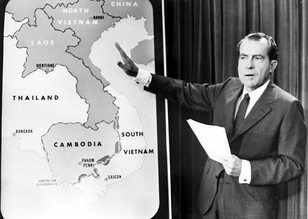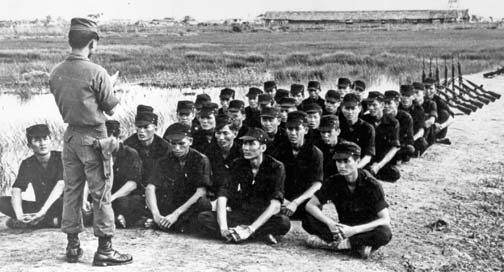


Vietnamization was President Richard Nixon’s strategy that he introduced in order to end the United States’ involvement in the Vietnam war. He believed that the U.S. should take American troops out of Vietnam but it had to happen slowly so his plan was to transfer all military responsibilities to South Vietnam’s military. For this to take process, the U.S. negotiated a treaty with North Vietnamese so that they could withdraw their troops and end the U.S.’ war with North Vietnam.
Nixon wanted to create a strategy to end the conflict with Vietnam because the U.S. had been sending troops since 1965 and Nixon took office in 1969. About 31,000 of the United States’ troops has already lost their lives and they were making no significant progress to defeat North Vietnam. Some of the reasons that resulted in little progress was the fact that they didn’t know the terrain very well whereas the Vietnamese knew the whole land and took advantage of it by hiding their bases where they knew the U.S couldn’t find them. Nixon knew he needed to get the troops out of Vietnam and the public was desperate to have the soldiers back home, but he did not want to seem like he was abandoning South Vietnam to Communist control. That is why Vietnamization had two parts to it, the first being the withdrawal of American combat forces and the second part was that they would put more effort in training the South Vietnamese so that they could take back their own land. Even with that, Vietnamization also offered programs whose purpose was to strengthen the government in Vietnam. While Vietnamization was taking place, North Vietnam saw an opportunity for them to act offensively and also used it to see if Nixon was willing to keep his strategy after seeing that the South Vietnamese army were not able to perform at the military level that they could with the aid of the United States.
When President Nixon arranged for a treaty with North Vietnam to be signed, it was seen as a way to declare peace between both nations. It stated that the United States had to agree to take out their troops of Vietnam in within 60 days and in return North Vietnam would cease-fire, return American troops that were captured and kept as prisoners of war, and they also agreed to recognize South Vietnam’s government while considering the values and ideals of their leadership. When Vietnamization was complete, the strategy was seen as successful and they claimed that not only had they evacuated all the troops but that the South Vietnamese were well equipped and trained in order to defend themselves from North Vietnam. On April 30, 1975, one is able to see that this claim was false since South Vietnam fell under the control of North Vietnam.
Vietnamization was both a failure and success for the United States. It was a success because they managed to approve the removal of American soldiers from Vietnam ground back to their territory while still helping the South Vietnamese to fight for their land. It was a failure because they failed to “protect”, as President Johnson stated in the Gulf of Tonkin Resolution, the South Vietnamese from the spread of Communism in their country.
http://www.history.com/topics/vietnam-war/vietnamization
http://thevietnamwar.info/how-effective-was-the-vietnamization/
Interesting post about what vietnamization was intended to do and managed to accomplish. I had forgotten that the north Vietnamese had taken over south Vietnam and reading your post has brought refreshers.
ReplyDeleteGreat post. It really talks about the policy of Vietnamization and its background depth. It is nice to have a more concise and clear explanation about this policy, rather than what it meant. I thought it was interesting that the policy both succeeded and failed, because the policy had been approved, but the Gulf of Tonkin Resolution was the cause of the failure.
ReplyDeleteGreat job concisely summarizing and evaluating Vietnamization. It seems as though Vietnamization was a good compromise in that it appealed to the student protesters at home who clamored for military withdrawal, but also satisfied those who saw it as crucial to aid the South Vietnamese in fighting the North. Why was it that the Vietnamese were so much less capable than the American troops? Did it relate to training, or technology?
ReplyDelete